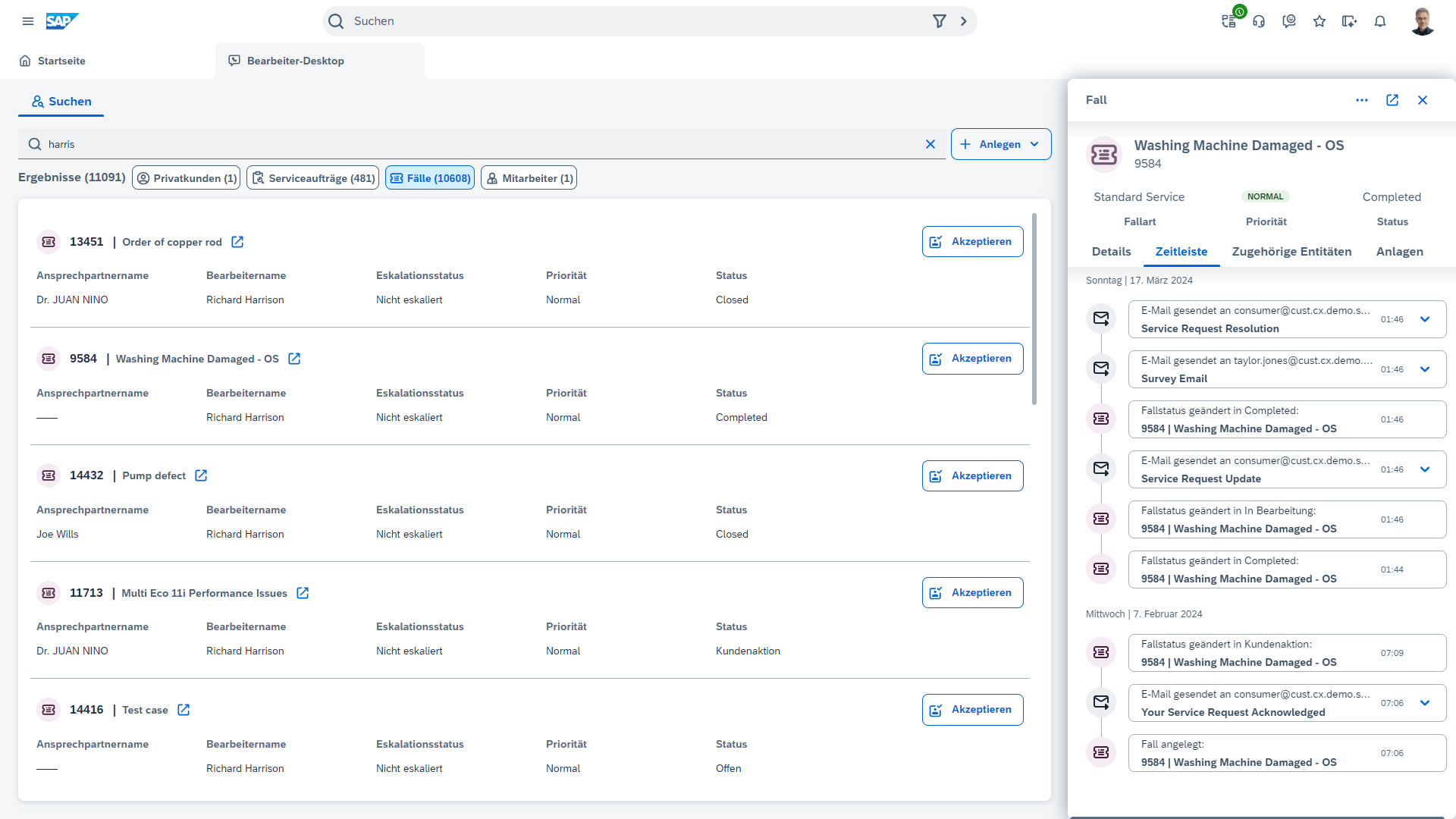SAP Service Cloud
This article describes what is behind the SAP Service Cloud solution, how it works and the advantages it provides.

Product Manager
- What is SAP Service Cloud?
- What are the previous versions of SAP Service Cloud?
- What are the functions of SAP Service Cloud?
- What advantages does SAP Service Cloud provide?
- What systems can SAP Service Cloud be integrated into by default?
- How does the ticket and case management work in SAP Service Cloud?
- How do AI-based chatbots and knowledge base provide support in SAP Service Cloud?
- What are the benefits of the connection to SAP Sales Cloud and an SAP ERP system?
- How can evaluations be made in SAP Service Cloud?
- How to optimize the user experience for service employees?
- Conclusion
- FAQ – Frequently asked questions
What is SAP Service Cloud?
SAP Service Cloud (formerly SAP Hybris Service Cloud or SAP Cloud for Customer) is the advanced SAP solution for case management processes (ticket management) and supports enterprises in fulfilling their after sales services. With SAP Service Cloud, service agents benefit from a cross-channel insight into all requests and, as a consequence, get a 360° view of customers. In this way, they are provided with a consistent and optimized customer experience.
The case management function has also been integrated into SAP Sales Cloud (CRM) and therefore provides all relevant information in a cross-system manner. In addition to a growing knowledge base, all service analyses, which are mapped on clear dashboards, are always available to the service employee in real time. They provide information on essential KPIs and employees in charge of service get a comprehensive overview of their team’s performance.
Frequently, direct contact in customer service results in numerous cross- and upselling options. To exploit this potential, it is recommended to make integrated use of the sales features of SAP Sales Cloud.
What are the previous versions of SAP Service Cloud?
The processing of service requests was part of the SAP SD module very early on. With SAP Cloud for Customer, a combination of a CRM and service system, the functionalities were delivered in the cloud for the first time. The combination of the two solutions enabled an all-round view of the customer and the term “360-degree view of the customer” was coined.
In combination with the other solutions in the Hybris Suite at the time, the solution was part of SAP’s customer-centric products. SAP Field Service Management was also integrated into this solution family in order to map the service process end-to-end.
Now under the umbrella of the CX Suite, the V2 of the SAP Service Cloud has been developed on a new technological basis. This utilizes the proven advantages of integration into the SAP Sales Cloud, but can also be operated separately. The proven functionalities have been improved based on the lessons learned from the existing solution and the interfaces have been made clearer. The new technological basis enables greater speed and simplified expandability of the solution, allowing companies to focus even better on their customers.
What are the functions of SAP Service Cloud?
What advantages does SAP Service Cloud provide?
What systems can SAP Service Cloud be integrated into by default?
SAP Service Cloud is part of SAP CX Suite. In this suite, marketing, sales and distribution, service and e-commerce solutions have been bundled. These applications are optimally integrated into each other. A great advantage of this SAP service solution is its proximity to the sales and commerce applications that the service cloud can be easily connected to. But also an ERP integration of SAP Service Cloud is provided by default and, as a consequence, can be easily set up. For technical field service management, SAP Field Service Management is an optimal solution, which can also be networked with SAP Service Cloud via the ERP system.
How does the ticket and case management work in SAP Service Cloud?
SAP Service Cloud optimizes the customer serivce through a central ticket and case management which bundles all entry channels from e-mail and phone to chats in one user interface. All relevant requests are displayed in a structured way so that service employees can process them directly without having to switch between different systems. This ensures an equal processing of all requests and increases the efficiency of the service team.
How do AI-based chatbots and knowledge base provide support in SAP Service Cloud?
Simple service requests are automatically answered through the integration of AI-based chatbots whereas more complex requests (including information already collected) are forwarded to a service employee. In this way, frequent standard requests can be solved without additional efforts and service employees can focus on more demanding cases. In addition, a knowledge base, fed with new solution proposals and therefore constantly growing, supports the quick processing of requests by proposing well-tried answers and approaches.
What are the benefits of the connection to SAP Sales Cloud and an SAP ERP system?
Through the connection to SAP ERP and SAP Sales Cloud, relevant data, such as previous acquisitions, service agreements or customer requests, can directly be integrated into processing and the automatic triggering of downstream processes, such as ordering spare parts or creating a service order.
When answering a service request, this additional information can be used, for instance, to refer to agreements made with a sales employee, registered products of the customer or orders placed. This additional information enables cross-channel and standardized statements made to the customers and, as a consequence, increases satisfaction. Moreover, this additional information increases the value of information given by the sales employee and make further queries obsolete.
How can evaluations be made in SAP Service Cloud?
Different evaluations are made available to optimize the service area in a sustainable way. Measures can be derived on the basis of these evaluations in order to improve the processes. Frequently used solution approaches that leave customers satisfied can be offered as recommendation for future requests or processes can correspondingly be specified by default. If a satisfying solution can rarely be found for a specific service request, a new knowledge article can be written or a product optimization triggered. In this way, the performance of the service team can be improved on a data basis and the customer satisfaction increased sustainably.
How to optimize the user experience for service employees?
If employees are satisfied, customers are much more likely satisfied as well. This is why SAP Service Cloud focuses on the user experience of the service agent. In case of an incoming request, all basic data of the customer will immediately and clearly be provided. An overview of the acquisitions made and previous service requests enables the employee to easily connect the request with the appropriate product. Possible solution proposals will then be provided on the basis of this information. The user interface can be used to document the procedure without having to call an additional application. The system-aided data query, the high information content and the focusing on requests that really require a service employee enormously reduce the workload of the employee. In this way, a high solution rate can be achieved in addition, which in turn increases the satisfaction of the employee.
Conclusion
SAP Service Cloud is the central solution for advanced and cross-channel customer service – integrated, intelligent and user-friendly. It bundles all service requests in a central system, creates a standardized data basis through the close interconnection with SAP ERP and SAP Sales Cloud and, as a result, enables a holistic 360 degree view of the customer. It does not only increase service efficiency but also customer satisfaction by means of an AI-based ticket management, increasing knowledge base and real-time analyses. At the same time, service employees benefit from an intuitive user interface, automated processes and intelligent recommended actions for quick support, clear statements and sustainable customer retention.





